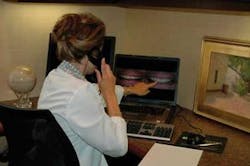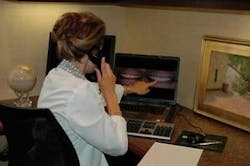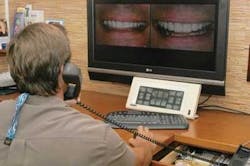10 steps to getting started with the Accreditation process
by Marty Zase, DMD, MAGD, FACD, AAACD
When I first joined the American Academy of Cosmetic Dentistry, I thought I was a pretty good cosmetic dentist. I was right. After all, I was doing good work. My patients were happy. My team was inspired. My peers were impressed. I was right. But it was not until I decided to pursue Accreditation in the AACD that I really understood what it means to be “excellent.” It took going through this Accreditation process to learn that good was just not good enough.
It is never too late, nor is it ever too early, to begin the process of moving from good to excellent. Even if you are unsure that you are ready for the challenge of gaining Accreditation, you can still begin now with a few important steps. These steps can help prepare you, just in case you decide to take the leap. In the process, your dentistry will improve and your results will begin to reflect this preparation.
Here are 10 suggestions that I encourage you to incorporate into your practice:
1) Take photos: Purchase a high-quality digital camera and use it. Single lens reflex cameras are most appropriate, and to comply with AACD guidelines, make sure it is capable of capturing images in RAW mode of at least 5 megapixels each. Take a full set of 12 AACD “before” images of every case that has any cosmetic component to it. (The guidelines for these images are in the Photography Guide available from the AACD.) If the case comes out well, stockpile it. If not, learn from it. Every case has something to teach you, and you can always see more in photos than you can in the mouth because nothing is moving. The more you look at these images, the more you will begin to see.
2) Critique your work: As you spend more time viewing your own work, critique it. Enlarge the images on your computer monitor (or better yet, project them). Look carefully at the shapes, margins, line angles, texture, anatomy, shade variations, overall appearance, and balance from one side to the other. See how much you missed observing in the mouth. Analyze what you did right, as well as what could use improvement.
3) Take courses: As you discover areas where you could use a little help, take courses in those areas. There are many courses available from AACD-recommended sources that are deemed helpful to those seeking Accreditation. Check out AACD Recommended Courses offered by members of the University Advisory Council, Private Educators Promoting Accreditation, and the AACD itself.
4) Learn the rules: The rules for Accreditation are specific. They have to be. Learn them accurately. Do not accept any rumors as facts. Everything you need to know is explicitly delineated in the Accreditation guidelines. Make sure you have a current set of the guidelines since they are continually tweaked to improve the process and your chances for passing. They can be downloaded from the AACD Web site at www.aacd.com or via mail by contacting the AACD credentialing department at (800) 543-9220.
5) Join the AACD: This might be the best investment you ever make in cosmetic dentistry. You will gain invaluable insight into Accreditation through cases that are analyzed in issues of the AACD Journal of Cosmetic Dentistry. Membership also brings you ownership in the process. You have gained a partner, the AACD organization, to help in this journey. You can even ask questions and share ideas on the AACD members only List-Serv.
6) Attend the annual scientific sessions: The camaraderie alone is worth the price of tuition, and educational opportunities abound. Participate with others who are raising their level of cosmetic dentistry services. Learn from the best. Even between courses, you will share with experts in the convention hall corridors and at luncheons. There is no better place on the planet to congregate with as many cosmetic dentistry gurus and other dental professionals at one time, in one place, and who are focused on cosmetic dentistry. The exposure to the AACD level of excellence and the excitement it produces is not only observable, but contagious. In fact, there is an entire track of courses delivered throughout each conference that is dedicated to Accreditation cases. These courses cover what is sought in each case type, and how to achieve Accreditation-level results. You might even consider bringing your team so they will be exposed to what you are trying to achieve. Your team members then can become your best means of support during the process while they share your journey with you.
7) Take the written exam: This exam tests your overall knowledge in the many areas associated with cosmetic dentistry. Those who keep current with the changes and improvements in the field have little to fear from this exam. It is designed to test your knowledge, but also to help determine if you are ready to move forward. Suggested reading lists and practice exams are available on the AACD Web site. Once you pass the written exam, the five-year clock to complete Accreditation begins.
8) Take the workshops: The required workshops provide a visual as well as factual introduction to Accreditation, its goals, and also the criteria used to evaluate cosmetic dentistry. The workshops are educational. The Guide to Accreditation Criteria (which is delivered at the workshop or is available online) is a reliable mini-text and photo guide that shows what works in excellent cosmetic dentistry, and what does not. It should be owned and studied by the cosmetic dentist and his or her lab partner so that the principles of cosmetics are well understood and similarly focused upon by all members of the cosmetic team.
9) Get a mentor: Accreditation examiners are available to mentor those candidates who would like help. Avail yourself of this opportunity. Where else are you likely to get one-on-one assistance from such reliable sources with a challenge of this magnitude? We are here to help. Use us.
10) Commit to excellence: This is the key. Accreditation is not just about improving the look of your patients. It is also not about perfection. It is about proving that you understand what excellence is, and that you are capable of producing it. Accreditation takes the commitment to dedicate one’s time to developing the eye and the skills necessary to provide the best of cosmetic dentistry services. Now you are ready to submit your first case. The journey toward Accreditation is difficult, challenging, rewarding, and occasionally frustrating. But, for those who earn Accreditation, the journey is the best learning experience of their cosmetic dentistry lives. Are you ready to get started?
Yes, when I first joined the AACD, I thought I was a pretty good cosmetic dentist. I was right. But it took going through the Accreditation process for me to eventually understand what is meant by “Excellence in Cosmetic Dentistry.”
Marty Zase graduated from Tufts and was a clinical instructor in restorative dentistry. Well-published in the field of cosmetic dentistry, he lectures internationally. He has a Mastership from the Academy of General Dentistry, Accreditation from the American Academy of Cosmetic Dentistry, and a Fellowship in the American College of Dentists. He is the immediate Past President of the AACD, and serves on its Board of Accreditation Examiners. Dr. Zase practices in Colchester, Conn. Contact him at [email protected].


